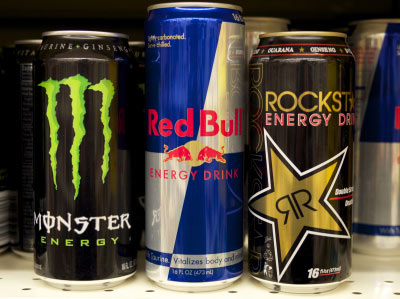|
Young children may face serious health risks from popular energy drinks, such as Monster, Red Bull and Rock Star, potentially causing seizures, heart problems and other life-threatening conditions, according to the findings of new research.
More than 5,000 calls involving problems with energy drinks were received by Poison Control Centers in the United States between October 2010 and September 2013, with more than 40% of the calls involving children under the age of 6 who drank Monster or another similar product without realizing what it was.
During a presentation at the annual Cardiac Scientific Sessions 2014 meeting of the American Heart Association (AHA), researchers warned about the risk of allowing young children access to the controversial energy drinks, which contain high amounts of caffeine and other stimulants.
Researchers analyzed reports involving energy drink problems among children from the National Poison Data System, which compiles information on calls to 55 Poison Control Centers throughout the United States. About one-third of the calls involving children involved serious adverse events that required further treatment, including seizures, nausea, vomiting, chest pain and erratic heart rhythms.
Nearly 60% of cases involved cardiovascular side effects, causing symptoms like abnormal heart rhythms and conduction abnormalities.
According to data released by the FDA in 2012, at least six deaths have been linked to energy drinks, including at least two deaths of teens that resulted in wrongful death lawsuits against the makers of Monster.
Steven Lipshultz, M.D., lead author of the study and professor of pediatrics at Wayne State University, said that in 42% of moderate to major injuries, the situation involved energy drinks that were mixed with alcohol.
Researchers indicate that the energy drinks are not intended for young children and are not safe for them to consume. Lipshultz is calling for a warning on all energy drink cans and bottles, warning parents of the risk allowing children access to the beverages.
A report from the Institute of Medicine estimates fewer than half of all poisonings in the US are reported to the National Poison Data system, suggesting that the true number of childhood injuries with energy drinks is substantially higher than the data reflects.
“Energy drinks have no place in pediatric diets,” Lipshultz said. “The reported data probably represent the tip of the iceberg.”
People with underlying health conditions are especially at risk, he noted. Those with conditions like attention deficit hyperactivity disorder and diabetes, or those taking medications, should especially be concerned and vigilant when drinking these products.
Energy Drink Health Concerns
Researchers said it is difficult to know exactly how much caffeine is contained in each can or bottle of energy drinks like 5 Hour Energy, Red Bull and others, since they are often marketed as dietary supplements, which allow the manufacturers to avoid FDA regulations.
Energy drink manufacturers have compared the amount of caffeine in their products to that of hot beverages sold in coffee houses, but the products are often packaged in very large sizes and they are not sold in controlled environments like coffee houses, which typically would not serve young children. Energy drinks are widely available in convenience stores next to traditional soft drinks, typically packaged in very similar cans and using similar marketing techniques.
Many of the products contain pharmaceutical grade caffeine and additional caffeine from other natural sources. This much caffeine in one serving can cause a person’s heart to beat rapidly, increase blood pressure, or other nervous, digestive or cardiovascular system side effects, health experts warn.
Some energy drinks in many of the popular lines, like Monster and Red Bull, can contain up to 400 mg of caffeine per can. In comparison, a cup of coffee typically has around 100 mg of caffeine.
Caffeine poisoning can occur in adults at levels higher than 400 mg a day; however children under 12 can experience caffeine poisoning at only 2.5 mg per 2.2 pounds of body weight.
A study published in September backed up the new findings, revealing energy drinks like Rock Star and Red Bull may cause serious heart problems.
French researchers revealed the popular energy drinks may be linked to increased risk of angina, irregular heartbeats and even sudden death.
Another study concluded Monster and Rock Star energy drinks and others may affect the way the heart beats, causing more forceful contractions. The study, using MRIs, found people who consumed energy drinks had significantly increased heart contraction rates, causing more strain on the left ventricle, the portion of the heart involved in pumping blood from the lungs to the aorta and distributing it to the rest of the body.
The FDA is currently investigating health concerns surrounding the drinks after numerous adverse event reports have been submitted in recent years connecting energy drinks to severe injuries and deaths. According to information released in 2012, at least 37 adverse event reports have been received by the FDA involving health problems from Monster Energy drinks, including at least six deaths.
Amid aggressive marketing by the manufacturers, energy drink sales increased 240% between 2004 and 2009, and the number of caffeine overdose emergency room visits increased from 1,128 in 2005 to 16,055 in 2008. Approximately 56% of those visits involved individuals between the ages of 12 and 25 years. |
最新研究成果表明�,市面上流行的能量飲料會(huì)給孩子的身體健康帶來(lái)極大風(fēng)險(xiǎn)���。飲用諸如怪獸(Monster)�、紅牛(Red Bull)��、搖滾明星(Rock Star)之類的能量飲料可能會(huì)引起癲癇、心臟病以及其他致命的疾病���。
2010年10月到2013年9月����,多家美國(guó)中毒控制中心(Poison Control Centers)接到投訴能量飲料安全問(wèn)題的電話共5000多個(gè)���。其中反映年齡不到6歲的孩童誤喝“怪獸”等能量飲料的來(lái)電比例超過(guò)40%��。
2014年美國(guó)心臟協(xié)會(huì)(the American Heart Association)年度心臟科學(xué)會(huì)議上��,研究者們警告讓孩子飲用能量飲料存在健康風(fēng)險(xiǎn),這些爭(zhēng)議性的飲料含有大量的咖啡因和其他刺激性物質(zhì)���。
美國(guó)國(guó)家中毒數(shù)據(jù)系統(tǒng)(the National Poison Data System)收集了全美55所中毒控制中心接到的來(lái)電投訴���。研究者們對(duì)這些反映能量飲料問(wèn)題的投訴內(nèi)容進(jìn)行了分析,發(fā)現(xiàn)大約有三分之一的來(lái)電都反映幼童飲用能量飲料后產(chǎn)生了不良反應(yīng)需要進(jìn)一步的治療����。這些不良反應(yīng)包括癲癇、嘔吐��、胸痛和心率不齊。
同時(shí)�,近60%的來(lái)電投訴案例都都涉及心血管疾病,如引起心率不齊�、心脈紊亂紊亂等癥狀。
據(jù)2012年美國(guó)食品藥品監(jiān)督管理局(FDA)發(fā)布的數(shù)據(jù)顯示��,至少有6例死亡案件與能量飲料有關(guān)����。怪獸飲料公司也因其產(chǎn)品涉嫌造成2名青少年非正常死亡而被告上法庭。
韋恩州立大學(xué)(Wayne State University)兒科學(xué)帶頭人史蒂芬?利普舒茲(Steven Lipshultz)教授表示在中度至重度不良反應(yīng)中有42%涉及到飲用的飲料中混有酒精��。
研究者們指出能量飲料的目標(biāo)人群并非低齡兒童����,對(duì)他們來(lái)說(shuō)飲用該類飲料并不安全。利普舒茲教授呼吁公眾注意各種能量型飲料潛在的危險(xiǎn)�����,同時(shí)警告家長(zhǎng)孩子飲用后可能引起的健康問(wèn)題���。
據(jù)一份美國(guó)國(guó)家醫(yī)學(xué)院(the Institute of Medicine)的報(bào)告推測(cè)����,中毒數(shù)據(jù)系統(tǒng)所統(tǒng)計(jì)的能量飲料中毒數(shù)量不及實(shí)際發(fā)生的一半,兒童由能量飲料引起的不良反應(yīng)人數(shù)遠(yuǎn)超出統(tǒng)計(jì)數(shù)據(jù)�����。
“兒童食物中不應(yīng)出現(xiàn)能量飲料����,”利普舒茲教授說(shuō)道,“報(bào)告的數(shù)字很可能只是冰山一角���?���!?/p>
他指出身體素質(zhì)本身就存在問(wèn)題的孩子在飲用能量飲料后發(fā)生不良反應(yīng)的幾率更高����。尤其是那些注意力不集中�����,患有多動(dòng)癥����、肥胖癥以及長(zhǎng)期服用藥物的孩子更需要大人的高度警惕�。
能量飲料引起的健康問(wèn)題
研究者們表示很難知道每瓶像5小時(shí)能量(5 Hour Energy)����、紅牛這樣的飲料究竟含有多少咖啡因。因?yàn)樗鼈兺ǔW鳛槠胀ㄊ称愤M(jìn)入市場(chǎng)����,可以不受食品和藥品監(jiān)督管理局的規(guī)定約束。
能量飲料廠家常常拿自家產(chǎn)品的咖啡因含量與咖啡店所售的熱飲相比�。但通常他們的商品包裝更大而且產(chǎn)品銷售所面臨的管理環(huán)境比咖啡店更為寬松?��?Х鹊瓴粫?huì)針對(duì)低齡兒童銷售咖啡因飲料���。但在便利店就能買(mǎi)到能量飲料,它的旁邊常常擺放著傳統(tǒng)軟飲料�����。兩者包裝相似���,營(yíng)銷手段相仿��。
很多能量飲料含有藥物級(jí)別的咖啡因和提取自其他自然資源的添加劑咖啡因��。健康專家警告一次性攝入過(guò)量咖啡因會(huì)使心跳加快�、血壓上升,神經(jīng)��、消化或心血管系統(tǒng)出現(xiàn)問(wèn)題�。
每罐像怪獸、紅牛這樣的熱門(mén)能量飲料含有400毫克的咖啡因����,而一杯咖啡的咖啡因含量是100毫克。
一個(gè)成年人一天攝入咖啡因超過(guò)400毫克就會(huì)中毒�����。而12歲以下的兒童如果每2.2磅(約1kg)體重中含有2.5毫克咖啡因就會(huì)中毒�����。
2014年9月發(fā)布的一個(gè)研究結(jié)果也支持這些新發(fā)現(xiàn):搖滾明星��、紅牛這樣的能量型飲料會(huì)引發(fā)嚴(yán)重的心臟問(wèn)題�����。
法國(guó)研究學(xué)者指出飲用能量飲料有可能增加患心絞痛���、心率失常等疾病的風(fēng)險(xiǎn)�,情況嚴(yán)重者甚至?xí)馈?/p>
另一項(xiàng)研究結(jié)論表明怪獸����、搖滾明星及其他能量飲料會(huì)影響到心跳,導(dǎo)致心臟強(qiáng)烈收縮�。這項(xiàng)研究利用核磁共振發(fā)現(xiàn)飲用能量飲料的人心率容易加快,左心房負(fù)擔(dān)加重��,而左心房是全身血液循環(huán)的中樞���。
近年來(lái)美國(guó)食品藥品監(jiān)督管理局已經(jīng)收到多份有關(guān)不良反應(yīng)的報(bào)告����,它們都顯示能量飲料可能是一些疾病發(fā)生甚至導(dǎo)致死亡的原因�。目前管理局也正在就此問(wèn)題展開(kāi)調(diào)查。2012年的數(shù)據(jù)顯示���,管理局至少收到37份因怪獸飲料引起健康問(wèn)題的報(bào)告���,其中包括六例死亡案件。
2004年到2009年�����,能量飲料在商家瘋狂的營(yíng)銷策略下銷售額增長(zhǎng)2.4倍。而因過(guò)量攝入咖啡因到急診室就診人數(shù)從2005年的1128人增至2008年的1萬(wàn)6055人�����。其中56%的人年齡在12歲與25歲之間����。
(譯者 orchismessi 編輯 丹妮)
掃一掃,關(guān)注微博微信
 
|


